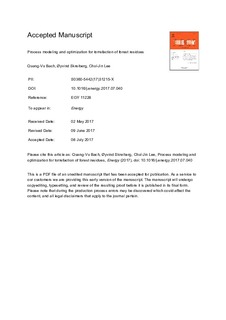| dc.contributor.author | Bach, Quang Vu | |
| dc.contributor.author | Skreiberg, Øyvind | |
| dc.contributor.author | Lee, Chul-Jin | |
| dc.date.accessioned | 2018-06-05T12:57:50Z | |
| dc.date.available | 2018-06-05T12:57:50Z | |
| dc.date.created | 2017-07-10T09:23:48Z | |
| dc.date.issued | 2017 | |
| dc.identifier.citation | Energy. 2017, 138 348-354. | nb_NO |
| dc.identifier.issn | 0360-5442 | |
| dc.identifier.uri | http://hdl.handle.net/11250/2500424 | |
| dc.description.abstract | This work aims to build a comprehensive biomass torrefaction model, which can provide a wide range of information essential for industrialization and commercialization of the process. Norwegian forest residue (birch branches) was chosen as feedstock. The model is capable of presenting detailed distributions of main and by-products from the torrefaction process. In addition, important fuel properties (ultimate analysis and heating value) of the main solid product after torrefaction can be predicted. The model is validated and simulation results show good agreement with available experimental data in the literature. Reduction in mass and energy yields as well as improvement in heating value of torrefied biomass with increasing torrefaction temperature are observed. Trends for carbon, oxygen and hydrogen contents are also consistent with other experimental works. Moreover, overall energy consumption and process energy efficiency can be estimated from the model. It reveals that drying accounts for 76-80% of the total heat demand. Furthermore, the process energy efficiency reduces with increasing temperature, thus torrefaction at high temperatures is not advisable. More importantly, process optimization shows that optimal conditions for torrefaction of birch branches are 30 min holding time and a temperature between 275 and 278 °C. | nb_NO |
| dc.language.iso | eng | nb_NO |
| dc.rights | Attribution-NonCommercial-NoDerivatives 4.0 Internasjonal | * |
| dc.rights.uri | http://creativecommons.org/licenses/by-nc-nd/4.0/deed.no | * |
| dc.title | Process modeling and optimization for torrefaction of forest residues | nb_NO |
| dc.type | Journal article | nb_NO |
| dc.type | Peer reviewed | nb_NO |
| dc.description.version | acceptedVersion | nb_NO |
| dc.source.pagenumber | 348-354 | nb_NO |
| dc.source.volume | 138 | nb_NO |
| dc.source.journal | Energy | nb_NO |
| dc.identifier.doi | 10.1016/j.energy.2017.07.040 | |
| dc.identifier.cristin | 1481645 | |
| dc.relation.project | Norges forskningsråd: 228726 | nb_NO |
| cristin.unitcode | 7548,70,0,0 | |
| cristin.unitname | Termisk energi | |
| cristin.ispublished | true | |
| cristin.fulltext | postprint | |
| cristin.qualitycode | 2 | |

